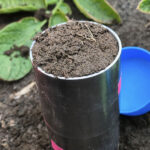
Sally Brown
BioCycle November 2013
We work with residuals. We use them to make valuable products such as green energy and soil amendments. By definition, the word residuals means they came from something else — some other industry or process. The old word for residuals was garbage and garbage was something that was supposed to just disappear. Nowadays, there is a whole new field in residuals management that derives from making the connection between the processes that generate the residuals and the quantity of residuals produced. For example, the U.S. EPA has been focusing more on reducing the amount of food waste generated, and less on how to manage the residuals.
The second part of this is to make the connection between the residuals-based product and how we live. Integrating use of residuals into every day considerations and tasks should be common practice, but residuals managers often work in a vacuum. This column is all about making the connection between regular life and residuals use. And what better way to do that than talking about life in Suburbia.
In November 2010, Andrew Trlica had the cover story in BioCycle. The article explained his research on how sites restored with organic amendments store more carbon than sites restored via conventional approaches such as using stored topsoil or fertilizer application (see “Measuring Carbon Storage In Biosolids-Amended Mine Land”). The research was part of his Master’s thesis and I was his faculty adviser. Residuals generators could take heart from those results, but the implications go beyond the generators to urban planners. That was the next part of his research. Here is how we made the connection.
Andrew took his data on how much soil carbon could be stored on one hectare of land and put that hectare in the Pacific Northwest, about a 40-minute commute into Seattle. He then calculated the impact if that land were returned to forest, either with or without the residuals amendment (in this case 100 tons of biosolids, a typical rate of amendment for restoring disturbed sites), or if the land were used to build houses. For the forest case, Andrew calculated how much carbon would be stored in the soils and in the trees, and how much carbon would be sequestered both with and without use of residuals.
For the houses, average values for home construction and density were used, thus that hectare would have about four houses, each about 245 m2 and covering about 10 percent of the land area. The houses would require roads for people to come and go. The roads would cover about 40 percent of the land, thus about half the land would be covered by structures of some sort. Using the houses and roads for 30 years would require energy for the homes and to maintain the roads. Added to this is the commuting, as availability of mass transit options is limited in a low density suburban subdivision.
Alternatives such as utilizing residuals to fertilize wheat or sending them to a landfill were considered. Alternatives for housing were to build slightly smaller homes in the urban core.
CO2 Emissions Tally
Here is what he found out. Restoring the land to forest yields lots of carbon credits. Without biosolids, the carbon stored over a 30-year period was substantial — about 110 tons of CO2 in the soils and another 180 tons in the trees. Adding biosolids to the mix increased that sequestration to 220 tons of CO2 in the soils and 275 tons of CO2 in the trees. Using biosolids for restoration turns out to be even better than using them to fertilize farm fields, largely because of the credits associated with growing trees. In this case, applying biosolids to wheat yields about 155 tons of CO2 credits, compared to the 495 tons of total CO2 credits for forest restoration. Both options are better than landfilling (330 tons of CO2 emitted for the 100 tons of biosolids that would be required to restore the soil).
In contrast, building homes resulted in significant emissions rather than sequestration. Although half of the land that stays in forest would sequester carbon (about 130 tons of CO2), it is the other half that hurts. Road construction and use emitted about 135 tons of CO2 over the 30-year period. Building the homes emitted 280 tons of CO2; living in them emitted 990 tons. Transport emissions over the 30-year period were 1,650 tons of CO2 emitted.
So what do we do? If the residuals generators and managers work with the urban planners in the decision making process, different options become clear. I like to think of this as the best of both worlds, or a melding of minds. In this ideal world, the houses would be built within the urban core and the hectare of land would be restored to forest with the assistance of biosolids. By building smaller homes within the urban core, emissions associated with construction and home occupancy are drastically reduced. In fact, the carbon emitted by building and living in the homes is compensated for or neutralized by the carbon stored in the soils and the trees. When homes are built in the urban core, transport emissions also fall from 1,650 to 375 tons of CO2. Granted, there will be some transport related emissions for people in the urban core to take advantage of the forest. And there will be savings relating to all that rainfall that can be intercepted by the soil rather than running off the roads.
If the urban planners and residuals generators work together rather than independently, solutions for multiple issues can be identified. Targeted use of residuals can maximize benefits, reaping rewards for all involved.
Sally Brown — Research Associate Professor at the University of Washington in Seattle — authors this regular column. Email Dr. Brown at slb@u.washington.edu.
References
Trlica, A. and S. Brown. Greenhouse gas emissions and the interrelation of urban and forest sectors in reclaiming one hectare of land in the Pacific Northwest. Environ. Sci. Tech., 2013, 47 (13), pp. 7250-7259.










